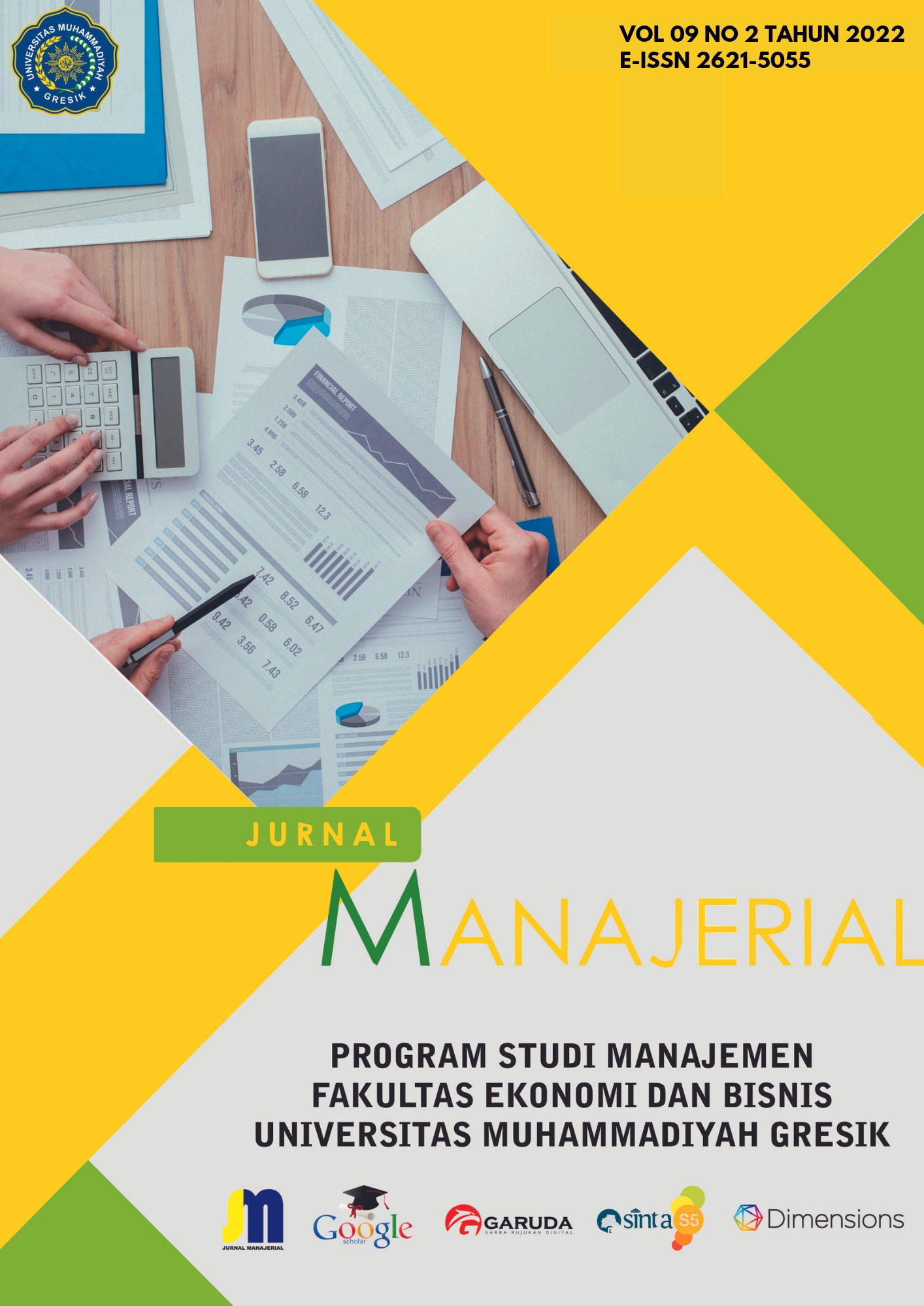Dispotition Effect And Momentum
DOI:
https://doi.org/10.30587/jurnalmanajerial.v9i02.3918Keywords:
Dispotition, Effect, Momentum, Returns, Capital, GainsAbstract
Background - An important challenge for behavioral finance is to find a direct relationship between the behavior of individual investors and asset price dynamics. One of irrational investors are most conspicuous in the financial markets is the tendency of some investors to sell winner stocks too early and keep losers stocks too long, called the disposition effect. Disposition effect can trigger a momentum in the stock price. Aim - To examine the past returns and disposition effect in predicting the momentum of stock returns. Desaign / methodology / approach - The data used in this study is weekly data. This study uses a variable capital gain overhang as a proxy disposition effect. Other variables used in this study is the stock return short, medium, and long period, turnover short, medium, and long period, and market capitalization. The analytical method used is regression and different test. Results and Discussion - Simultaneous test results also show that the variables of short period return, medium period return, long period return, short period turnover, medium period turnover, long period turnover, and market capitalization together have an effect on the capital gain overhang variable. The adjusted R2 value in this model shows that the independent variable in this equation is able to explain the dependent variable of 35.1%. Stocks with a low capital gain overhang (G1), have a low return value as well. Likewise, stocks with high capital gain overhangs (G4), have high return values. The disposition effect is an important cause of momentum, stocks with high capital gain overhangs will have positive returns. From these results, it can be concluded that hypothesis 2 is supported, namely the disposition effect can predict the presence of momentum in stock returns. Conclussion - The results showed past returns can predict the momentum in stock returns and disposition effect could predict the momentum of stock return. Research Implication –This research can provide an overview of the anomalies that often occur in the capital market, particularly the existence of the disposition effect and momentum in the Indonesian capital market. Limitations – This research uses only one proxy, namely the capital gain overhang as a proxy for the disposition effect which was first developed by the research of Grinblatt and Han (2005) and there are no other proxies that can be used to compare research results
References
Barber, M. Brad, dan T. Odean. 2000. Trading is Hazardous to Your Wealth: The Common Stock Investment Performance of Individual Investors. Journal of Finance 55(2): 773-806.
Barberis, N., Shleifer, A., dan Vishny, R. 1998. A Model of Investor Sentiment. Journal of Financial Economics 49: 307–43.
Bernard, V. dan Thomas, J. 1990. Evidence that Stock Markets Do Not Fully Reflect the Implications of Current Earnings for Future Earnings. Journal of Accounting and Economics 13: 305–41.
Bodie, Z., Kane, A., dan Marcus A. J. 2011. Investment and Portfolio Management. New York: McGraw Hill.
Boujelbene, M., Younes, B., dan Abdelfettah, B. 2009. Disposition Effect and Momentum: Prospect Theory and Mental Accounting Framework. Journal of Behavioral Finance 6(2): 52–64.
Cutler, D., Poterba, J., dan Summers, L. 1991. Speculative Dynamics. Review of Economic Studies 58: 529–46.
Dacey, R. dan P. Zielonka. 2008. A Detailed Prospect Theory Explanation of the Disposition Effect. Journal of Behavioral Finance 9: 43–50.
Daniel, K., Hirshleifer, D., dan Subrahmanyam, A. 1998. Investor Psychology and Security Market Under- and Overreactions. Journal of Finance 53: 1839–1886.
De Bondt, W. dan Thaler, R. 1985. Does the Stock Market Overreact? Journal of Finance 40(3): 793-808.
De Bondt, W. F. 1993. Betting on Trends: Intuitive Forecasts of Financial Risk and Return. International Journal of Forecasting 9: 345–357.
Dhar, R. dan N. Zhu. 2006. Up Close and Personal: Investor Sophistication and the Disposition Effect. Management Science 52: 726–740.
Fama, E. F dan K. R. French. 1993. Common Risk Factors in the Returns on Stocks and Bonds. Journal of Financial Economics 33: 3-56.
Feldman, T. dan G. Lepori. 2015. Asset price formation and behavioral biases. Review of Behavioral Finance Journal. Vol. 8, No. 2, pp. 137-155.
Fernandes, J. dan J. Renato. 2008. Momentum and Reversal Puzzle in Emerging Markets. Journal of Behavioral Finance 5(3): 54-71.
Frazzini, A. 2006. The Disposition Effect and Under-Reaction to News. Journal of Finance 61(4): 2017-2046.
Garling, T., dan M. Blomman. 2016. Affect account of disposition effect and consequences for stock prices. Review of Behavioral Finance Journal. Vol. 9, No. 2, pp. 187-202.
Goo, Dar Hsin, Sze Hsun, dan Chi Feng. 2010. A Study of Disposition Effect for Individual Investor in The Taiwan Stock Market. Journal of Finance 46(1): 108-119.
Grinblatt, M dan B. Han. 2005. Prospect Theory, Mental Accounting, and Momentum. Journal of Financial Economics 78(2): 311-339.
Grinblatt, M. dan M. Keloharju. 2001. What Makes Investors Trade? Journal of Finance 56: 589–616.
Grinblatt, M. dan T. J. Moskowitz. 2004. Predicting Stock Price Movements from Past Returns: The Role of Consistency and Tax-Loss Selling. Journal of Financial Economics 71(3): 541–579.
Habbe, A. H. 2006. Pengujian Heuristik Representativeness dan Anchoring Adjustment atas Perilaku Overreaction/Underreaction Investor terhadap Info Laba dan Konsekuensinya pada Prediksi Laba dan Penilaian Saham. Disertasi. Yogyakarta: FEB UGM.
Hong, H. dan J. C. Stein. 1999. A Unified Theory of Underreaction, Momentum Trading, and Overreaction in Asset Markets. Journal of Finance 54(6): 2143-2184.
Hur, Jungshik, M. Pritamani, dan V. Sherma. 2010. Momentum and the Disposition Effect: The Role of Individual Investors. Journal of Financial Management: 1155-1176.
Jegadeesh, N. dan Titman, S. 1993. Returns to Buying Winners and Selling Losers: Implications for Stock Market Efficiency. Journal of Finance 48(1): 65-91.
Jonsson, S., I. Soderberg, dan M. Wilhelmsson. 2016. An investigation of the impact
of financial literacy, risk attitude, and saving motives on the attenuation of mutual fund investors’ disposition bias. Managerial Finance Journal. Vol. 43. No. 3, pp. 282-298.
Kahneman D dan Tversky A. 1979. Prospect Theory: An Analysis of Decision Under Risk. Econometrica 47(2): 263-291.
Kubinska, E., L. Markiewicz, dan T. Tyszka. 2012. Disposition Effect Among Contrarian and Momentum Investors. Journal of Behavioral Finance 13: 214-225.
Liu, X., H. Zhang, S. Zhao, dan P. Sawicki. 2017. Can prospect theory explain the disposition effect? An analysis based on value function. China Finance Review International.Vol. 8, No. 3, pp. 235-255.
Odean, T. 1998. Are Investors Reluctant to Realize Their Losses? The Journal of Finance 53: 1775–1798.
Parveen, S., Z. Saati, dan T. Bashir. 2021. Examining investors’ sentiments, behavioral biases and investment decisions during COVID-19 in the emerging stock market: a case of Pakistan stock market. Journal of Economic and Administrative Sciences.
Rabin, M. 2002. Inference by Believers in The Law of Small Numbers. Quarterly Journal of Economics 117: 775–816.
Shefrin, H. dan M. Statman. 1985. The Disposition To Sell Winners Too Early and Ride Losers Too Long. Journal of Finance 40(3): 777–790.
Tyszka, T., P. Zielonka, R. Dacey, dan P. Sawicki. 2008. Perception of Randomness and Predicting Uncertain Events. Thinking & Reasoning 14: 83–110.






























 P-ISSN: 2354-8592 __ E-ISSN: 2621-5055
P-ISSN: 2354-8592 __ E-ISSN: 2621-5055 
